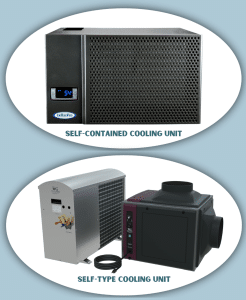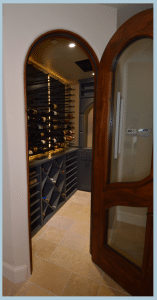For homeowners, a wine cellar serves as a sanctuary for a collection of wines with memorable stories. Therefore, it is crucial to maintain the appropriate conditions within the cellar.
However, what happens when you hire a contractor who lacks knowledge about wine cellars and preservation? Unpleasant consequences such as mold growth, excessive heat, increased electricity costs, and the deterioration of wines can arise. Our client encountered these issues before consulting our services to fix the situation.
A homeowner in San Clemente, Orange County, encountered a problem with her wine cellar cooling units. The humidity and temperature in her wine cellar were inadequate, causing rapid mold growth. She tried replacing the cooling unit multiple times, but they proved ineffective. Hence, she consulted an expert to fix her wine storage problem.
An expert team in wine cellar construction and design in Orange County, California, created a renovation project for a client in Orange County. His primary focus was to optimize the cooling system and insulation of the wine cellar.
What Needs to be Repaired in the Cellar Cooling Units
Upon inspecting the wine cellar, the team discovered that the insulation and cooling system needed to be revised and compatible. Our team from Orange County wine cellar builders suggested a total wine cellar makeover to the client, including replacing the cooling unit with one of the proper sizes to which the client approved. It turned out to be an impressive transitional wine cellar in her residential space.
Learn the Types of Wine Cellar Cooling Units
There are two primary types of wine cellar cooling units: self-contained cooling units and split-type cooling units. Each class has unique characteristics, and the choice depends on your specific project requirements and preferences.
The self-contained cooling unit is commonly used and can be easily installed by builders directly into your wine cellar. However, hiring a professional installer to maximize its cooling capacity is advisable. Typically rectangular (occasionally cubical for specific models), it is fitted into the wall with its exhaust vent protruding outside the wine room. This cooling unit’s components are enclosed within the unit, hence the name “self-contained.” This type of cooling unit works well for small wine rooms.
On the other hand, split-type cooling units have their condenser, coils, and other parts separated. Usually, only the vent is visible within the wine cellar. Cables, lines, condenser, evaporator, and other cooling system components are placed in the garage or soffit above the wine cellar. Concealing these parts helps eliminate the bulky appearance of the cooling system in the wine room. Depending on the installed ducting system, this cooling system produces minimal to zero noise. It is an ideal choice for more extensive wine cellars.
Helpful Guide to Choosing the Wine Cooling Units for Your Wine Cellar
1. Determine the R-Value of your cooling unit.
R-Value measures the capacity of the overall materials in a structure to resist heat transfer in a design or building. The higher the R-Value, the greater the insulating power of your wine cellar. This means your wine cellar won’t be easily affected by sudden temperature and humidity fluctuations outside its walls. It’s essential that you know the R-Value for your wine room.
We will calculate the heat load to determine what insulation level they will need. It’s one more reason why it pays to work with wine cellar experts.
2. Drywall alone won’t be enough to maximize the insulation for your wine cellar.
Yes, since You can’t rule out that there will always be a possibility that condensation will happen inside the cavity of your wall without any additional insulation applied to it.
Condensation in the wall cavity is not wanted. It could directly affect the humidity in the wine room. As a solution, it is advisable to have a spray foam application between wall cavities to retard the formation of water droplets in it.
3. Know the total area of your wine cellar.
It is one of the things you should consider before buying a wine cooling system. As mentioned above, a self-contained cooling unit can refrigerate a small wine cellar. But, for larger areas of wine storage, a split-type cooling unit should be your choice.
4. Always check the wine cellar for any gaps or leaks.
With the wine cellar sealed, the cooling unit could work more efficiently. It means the team will work less but maintain the temperature and humidity. Leaks could lessen the cooling system’s efficiency since air outside would seep in and continuously disrupt the cooling process.
Home Renovation Project Successfully Made by Bella Vita Wine Cellars Experts
The expert team had to remove the entire wine racking system. They replaced it with metal wine racks using black satin stain wine pegs built exclusively by the Bella Vita Wine Cellars.
Then they installed an Alderwood back panel which included LED lighting in it. For the cooling system, they got a WhisperKool ceiling mount split-type cooling unit for it.
Lastly, the team crafted a custom wine cellar door with a double-paned glass panel. The door also has a self-sealing mechanism to seal the wine cellar when it closes. To retard condensation and heat transfer within the wall cavity, the team sprayed 5 inches between walls.
The wine cellar looks more beautiful and elegant now with wine pegs installed. Wines look more presentable now with the Alderwood back panel and wine cellar lighting using LED lighting behind it.
The team also built a custom wooden arch to add to the aesthetics. It could also be used as an area to decant the wines. Temperature and humidity in the wine cellar were maintained consistently. There’s no more mold growth on the surfaces of the wine racks.
Our client never had any problem with her cooling system once the team finished remodeling her wine cellar. She no longer had to worry about ruined wines because of the extreme humidity and temperature fluctuations inside her wine cellar.
Changing her cooling unit faster than it was designed to last was now a thing of the past. With the client’s cooling system problem resolved, we take pride in saying that the project has lived up to our goal of providing solutions to our clients.
Talk to our experts in Orange County to replace or repair your wine cellar cooling units!
Bella Vita Wine Cellars and our wine cellar experts in Orange County can work on all types of wine cellars, including glass ones.
We find the right solutions to your problems and needs and offer complete wine cellar construction services, from designing to building and periodically maintaining your cellar.
Whether you’re located in Rossmoor, Corona Del Mar, San Juan Capistrano, Surfside, Dana Point, San Clemente, Costa Mesa or in a nearby city in Orange County, our team can assist you in fixing and building your wine cellars in the best way possible.
Contact any of our specialists today and let us help you with your wine cellar cooling units and other related wine storage concerns.
You can reach us at +1 (714) 798 9858!






